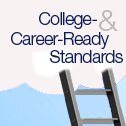There’s an ongoing debate about whether the common-core standards for kindergartners—and particularly one that requires them to read “emergent-reader texts"—are “developmentally appropriate,” as I wrote in a recent story.
Some say 5- and 6-year-olds should be focused on play, and that such a high-level reading standard will lead teachers to employ worksheets and drills. Others say the standards are compatible with play, and aren’t as restrictive as critics seem to think.

But what was interesting to me in reporting this story is a very basic question that wasn’t at the center of this argument: How many kindergartners are capable of doing this kind of work?
For the critics of the standards, developmentally appropriate is not about whether students can do this work but about whether they should. And for the proponents of the standards, there’s an underlying assumption that it’s possible for kindergartners to read emergent-reader texts—but how much of a stretch this will be, and how many students will feasibly be able to do it isn’t really a part of their defense.
What Literacy Coaches Say
I recently spoke with Donna Scanlon, a professor in the department of literacy teaching and learning at the University at Albany, about this question of ability. Scanlon has been doing research on early-literacy instruction for three decades and helped develop an approach to literacy instruction that has served as a model for response-to-intervention.
So what percentage of kindergartners should be able to read emergent-reader texts by the end of the year? “With solid instruction and intervention—all of them, I believe,” she said. “In a study where we had 1,400 kids, I can think of one child we had that just couldn’t get started with reading.”
But the “solid instruction and intervention” part is key, she explained. In the study she referred to, teachers were all trained on and implementing a structured reading-intervention program. And worksheets and drills do not count as appropriate instruction for kindergartners, Scanlon said.
The definition of emergent-reader texts is crucial as well, she said. As I wrote in my story, the common core defines emergent-reader texts as those with short sentences made up of learned sight words and consonant-vowel-consonant words. Scanlon added that these texts should also be introduced to the child before they are read.
In response to my query, Scanlon reached out to seven current and former literacy coaches as well. She asked them to estimate what percentage of students, given good instruction, could read emergent-reader texts by the end of kindergarten. Their answers ranged from 70 percent to 100 percent, with most of their estimates on the higher end of the range.
Here’s what one former literacy coach wrote:
“I would think ... given the RIGHT instruction (I’m assuming by right instruction that this includes a core program and quality responsive, tiered early-intervention support) that, at the minimum, 90 percent of the students would be reading emergent-reader texts by the end of K. I recall very few students in my career who, if they had both of these conditions, would not have been able to call themselves READERS in June of their kindergarten year.”
It would be great to hear from other early-childhood educators in the comments below. Do you agree with these estimates? And if most kindergartners can learn to read, do you think that means they should? Why or why not?
